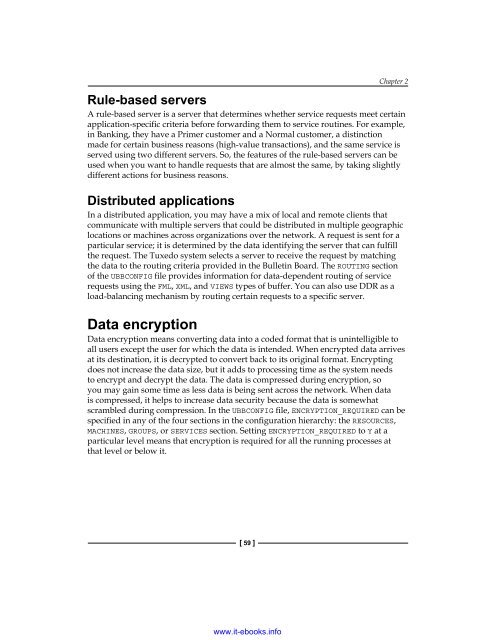www.it-ebooks.info
You also want an ePaper? Increase the reach of your titles
YUMPU automatically turns print PDFs into web optimized ePapers that Google loves.
Chapter 2<br />
Rule-based servers<br />
A rule-based server is a server that determines whether service requests meet certain<br />
application-specific cr<strong>it</strong>eria before forwarding them to service routines. For example,<br />
in Banking, they have a Primer customer and a Normal customer, a distinction<br />
made for certain business reasons (high-value transactions), and the same service is<br />
served using two different servers. So, the features of the rule-based servers can be<br />
used when you want to handle requests that are almost the same, by taking slightly<br />
different actions for business reasons.<br />
Distributed applications<br />
In a distributed application, you may have a mix of local and remote clients that<br />
communicate w<strong>it</strong>h multiple servers that could be distributed in multiple geographic<br />
locations or machines across organizations over the network. A request is sent for a<br />
particular service; <strong>it</strong> is determined by the data identifying the server that can fulfill<br />
the request. The Tuxedo system selects a server to receive the request by matching<br />
the data to the routing cr<strong>it</strong>eria provided in the Bulletin Board. The ROUTING section<br />
of the UBBCONFIG file provides <strong>info</strong>rmation for data-dependent routing of service<br />
requests using the FML, XML, and VIEWS types of buffer. You can also use DDR as a<br />
load-balancing mechanism by routing certain requests to a specific server.<br />
Data encryption<br />
Data encryption means converting data into a coded format that is unintelligible to<br />
all users except the user for which the data is intended. When encrypted data arrives<br />
at <strong>it</strong>s destination, <strong>it</strong> is decrypted to convert back to <strong>it</strong>s original format. Encrypting<br />
does not increase the data size, but <strong>it</strong> adds to processing time as the system needs<br />
to encrypt and decrypt the data. The data is compressed during encryption, so<br />
you may gain some time as less data is being sent across the network. When data<br />
is compressed, <strong>it</strong> helps to increase data secur<strong>it</strong>y because the data is somewhat<br />
scrambled during compression. In the UBBCONFIG file, ENCRYPTION_REQUIRED can be<br />
specified in any of the four sections in the configuration hierarchy: the RESOURCES,<br />
MACHINES, GROUPS, or SERVICES section. Setting ENCRYPTION_REQUIRED to Y at a<br />
particular level means that encryption is required for all the running processes at<br />
that level or below <strong>it</strong>.<br />
[ 59 ]<br />
<strong>www</strong>.<strong>it</strong>-<strong>ebooks</strong>.<strong>info</strong>



